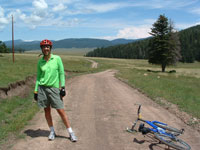The southwestern travelogue continues, this week taking us to the Valles Caldera, where Lissa and I took advantage of their decision to cautiously open things up for a mountain biking experiment this weekend.
We pronounce the experiment a success, though the fact that we don’t really mountain bike made even the beginner trail a bit arduous.
I once described the Caldera as being, to a geologist, like “a secular sort of sacred ground.” It was there, in a volcanic formation, that Brent Dalrymple in the 1960s found the rocks that clinched the deal for the theory of plate tectonics, launching a revolution in earth science.
For that alone the Valles would be a spectacular place, but there’s so much more. Created in a massive volcanic eruption 1.2 million years ago that created a crater 15 miles wide, the Caldera is a geologic wonder. There’s no place short of an airplane where you can see the whole thing, because subsequent volcanic eruptions dotted the crater with massive volcanic humps. The humps are covered with pines (it was one of the humps on which Dalrymple found his Rosetta Stone), and beautiful meadowed valleys thread among them.
The problem is that until recently the bulk of the Caldera was in private hands. The federal government bought the land in July 2000, setting up a trust to administer it. It remains a working ranch, and public access is being slowly introduced, with an eye toward finding ways to let us in without screwing the place up.
This weekend’s mountain biking was one such experiment. They opened several routes, from the relatively less hard to the relatively more hard, along the old logging roads that cover the Caldera. They limited the numbers, and sold tickets. It wasn’t cheap – $20 each. But since the whole point of the Valles experiment in federal land management is to try to find ways for preservation to pay for itself, I didn’t mind.
Our ride took us across the main valley (that’s what you see in the background in the photo above) and up into the woods for a long, level traverse of one of the volcanic humps.
Red-winged blackbirds were everywhere in the valley, and mountain bluebirds. “If I was a bird, I’d live here,” Lissa said. We didn’t see any elk, but we could, uh, tell they had been there. (Last time I was there, when I went for the story linked above, we saw a huge herd of elk as we were leaving the place. Magnificent.)

